Driving Tool
FUKUSHIMA; Naoyuki ; et al.
U.S. patent application number 16/138607 was filed with the patent office on 2019-04-04 for driving tool. This patent application is currently assigned to MAX CO., LTD.. The applicant listed for this patent is MAX CO., LTD.. Invention is credited to Naoyuki FUKUSHIMA, Takamichi HOSHINO, Norimitsu SEKIGUCHI, Hiroshi TANAKA.
| Application Number | 20190099871 16/138607 |
| Document ID | / |
| Family ID | 63683044 |
| Filed Date | 2019-04-04 |
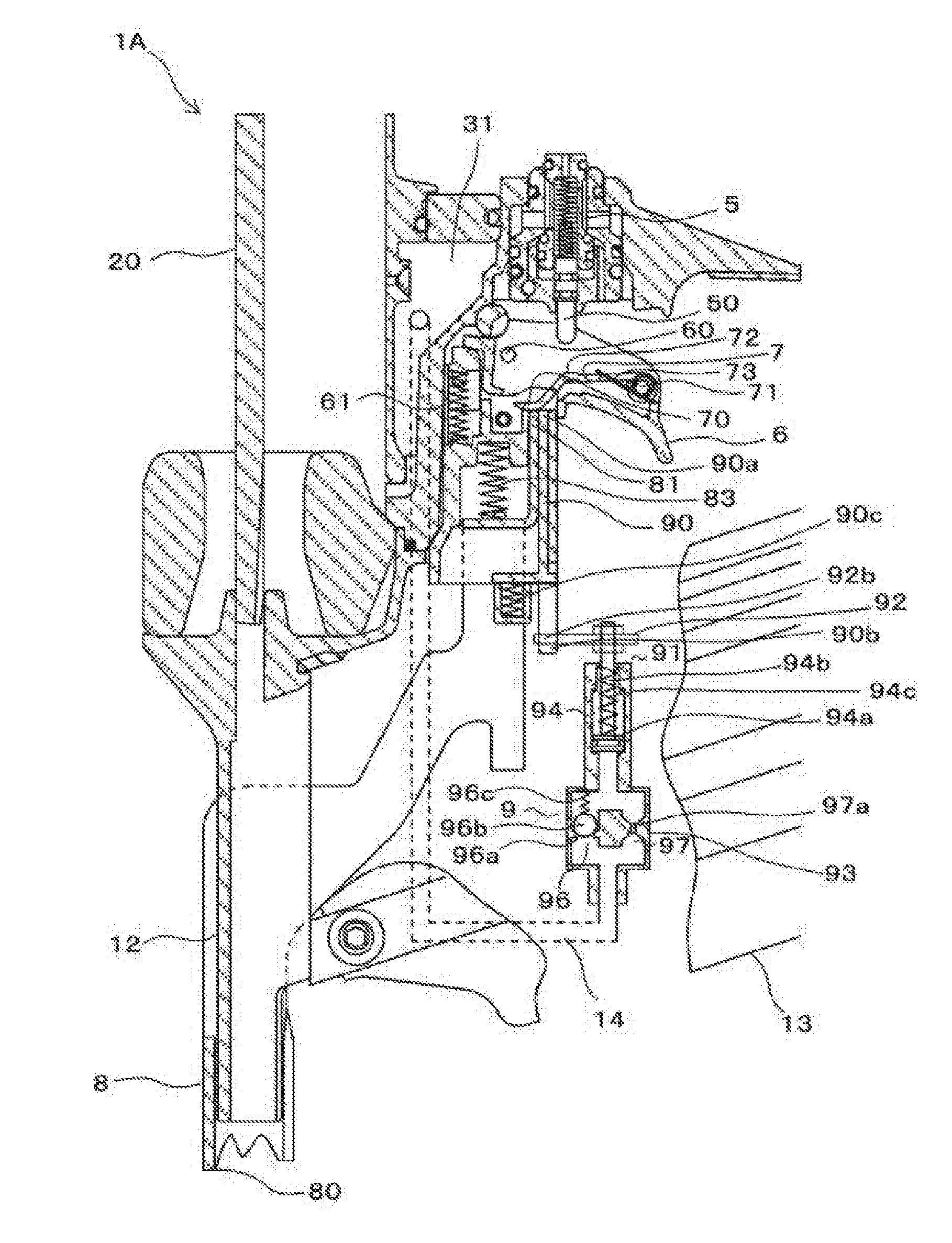
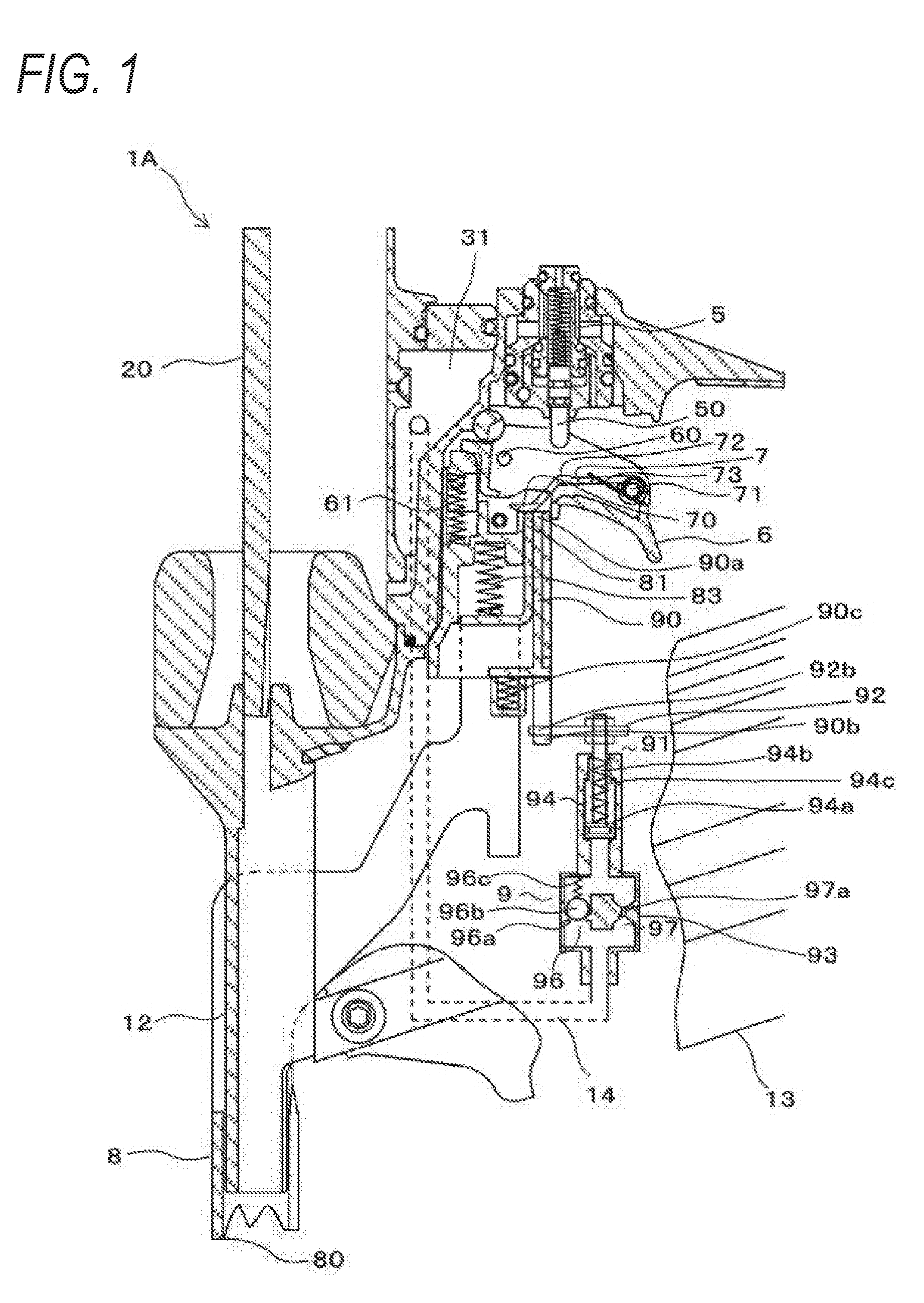
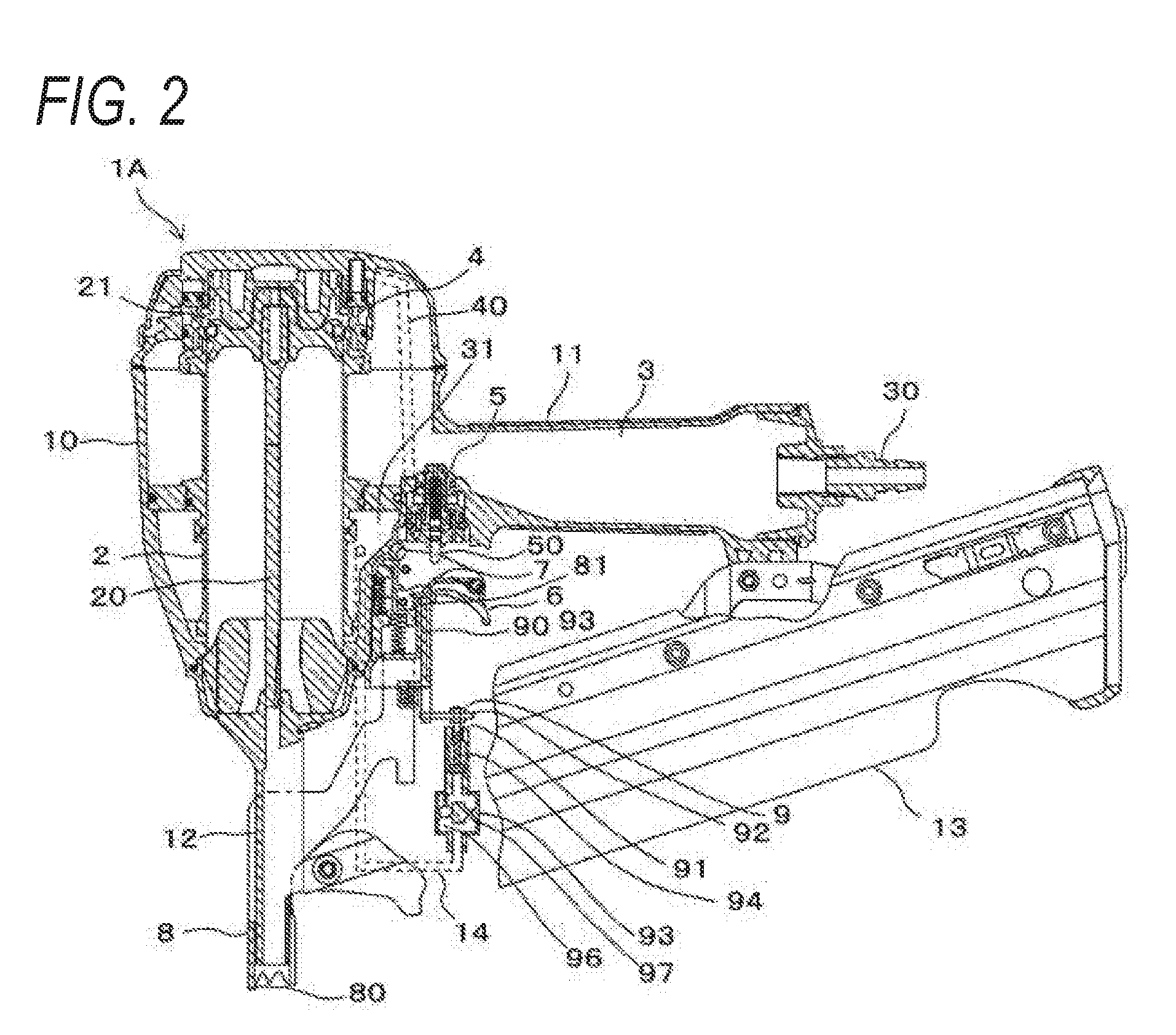
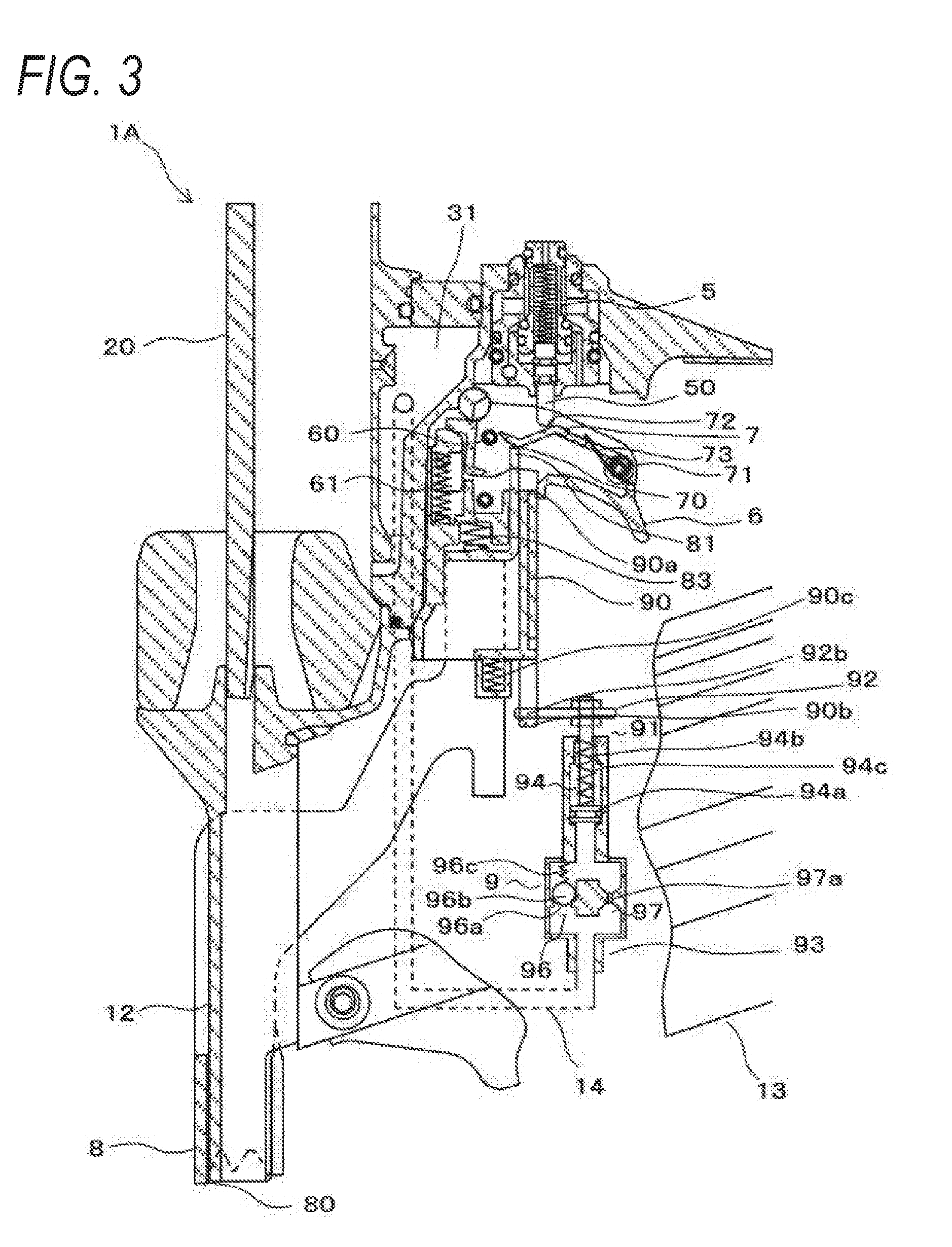
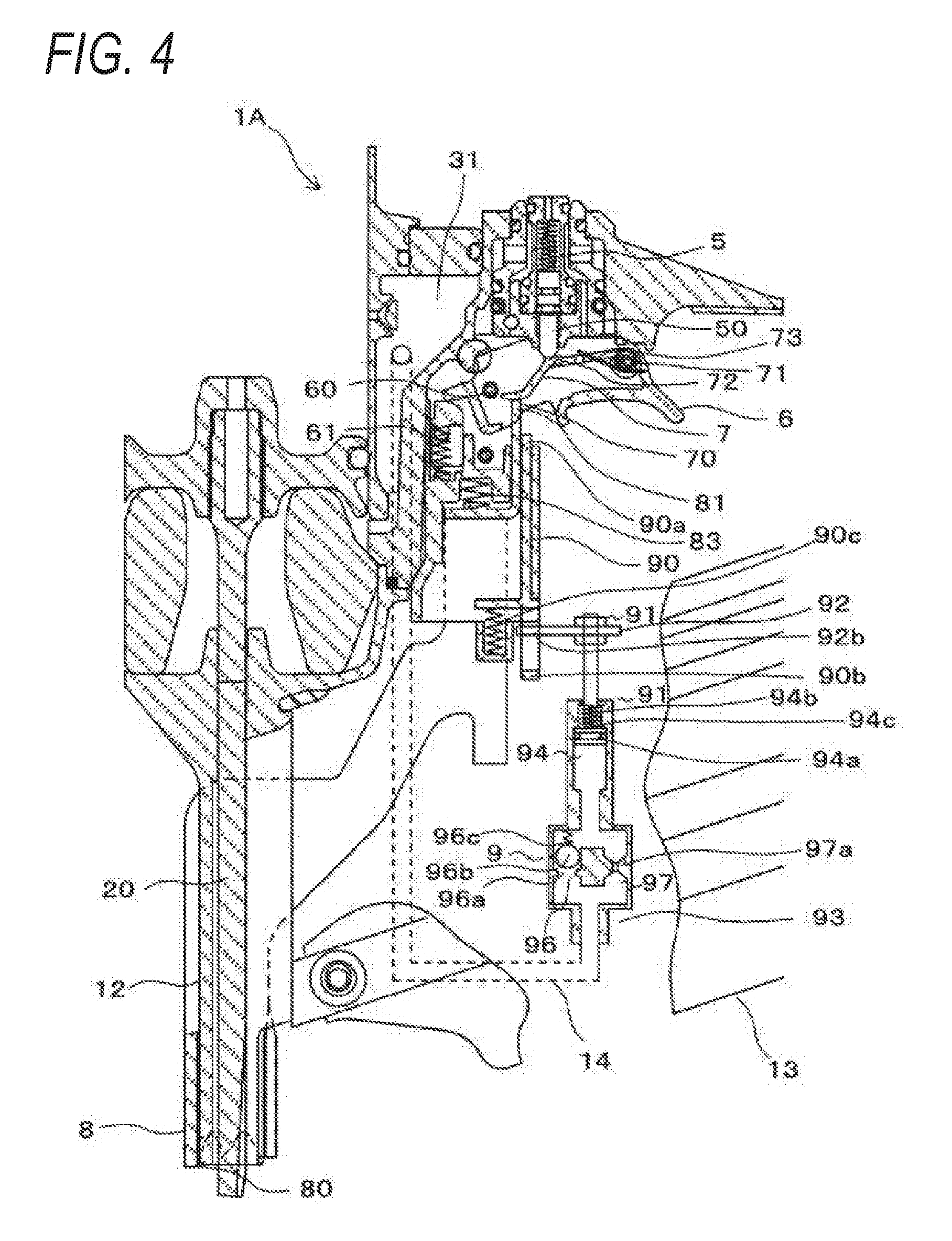
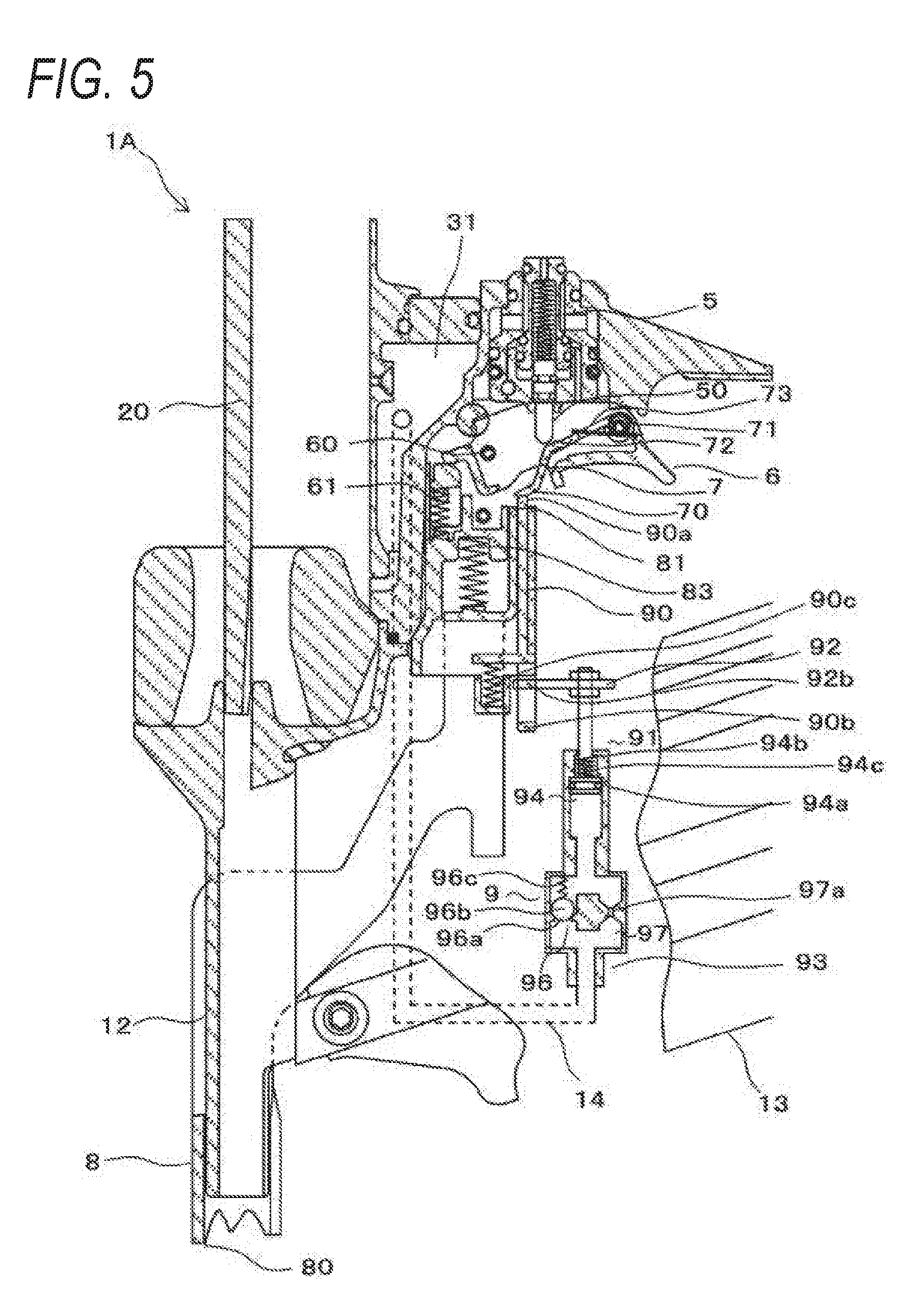
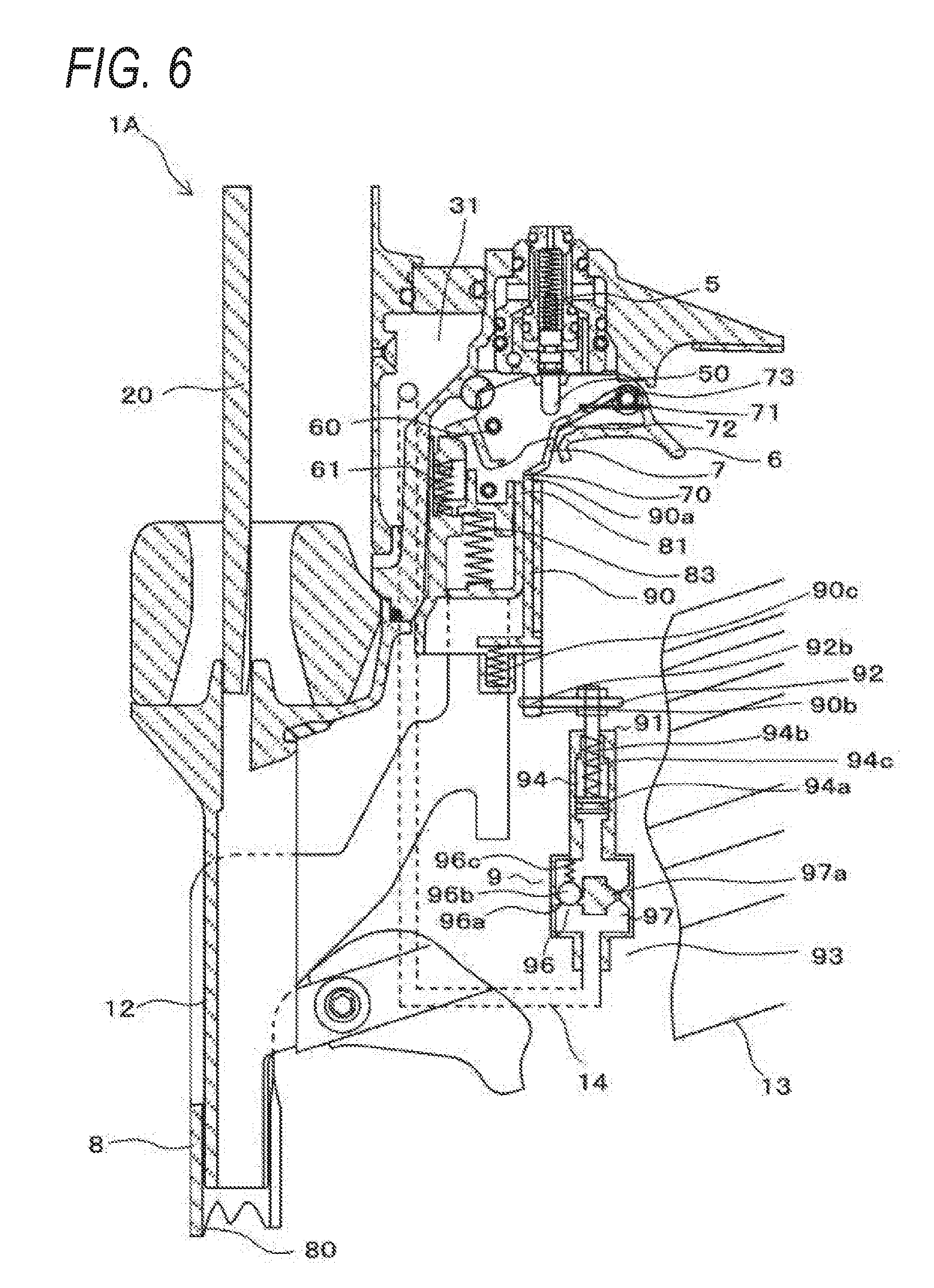
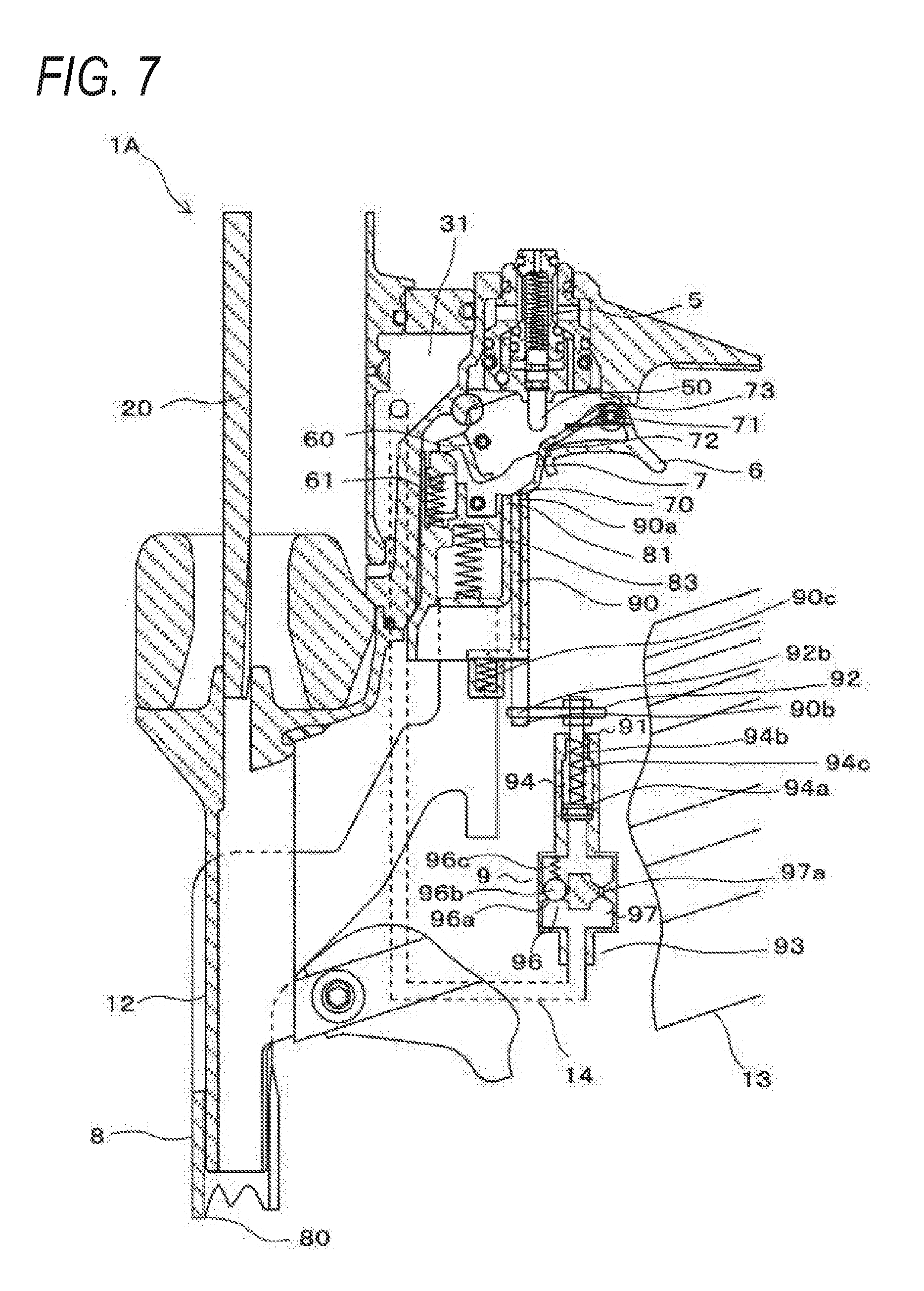
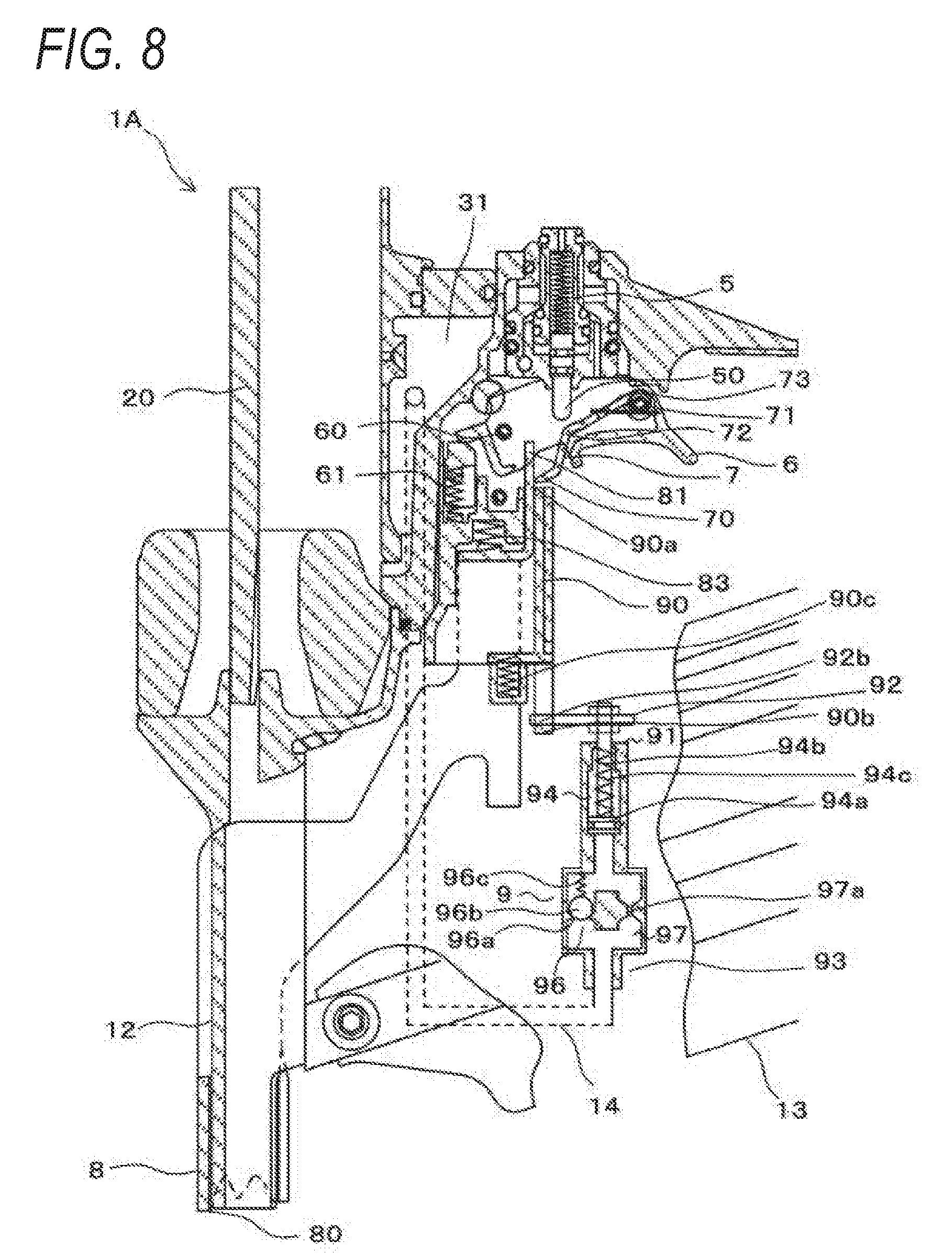
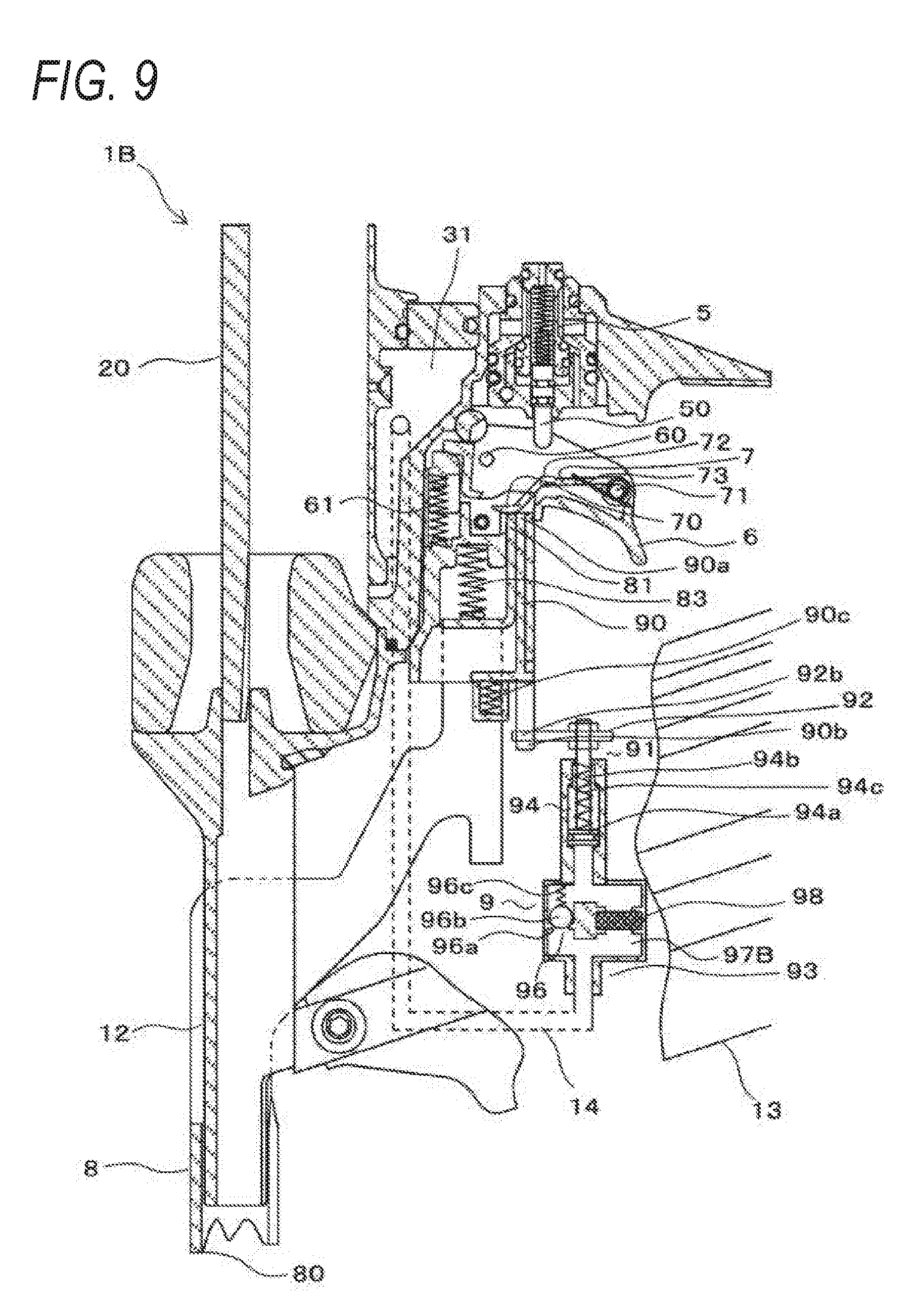
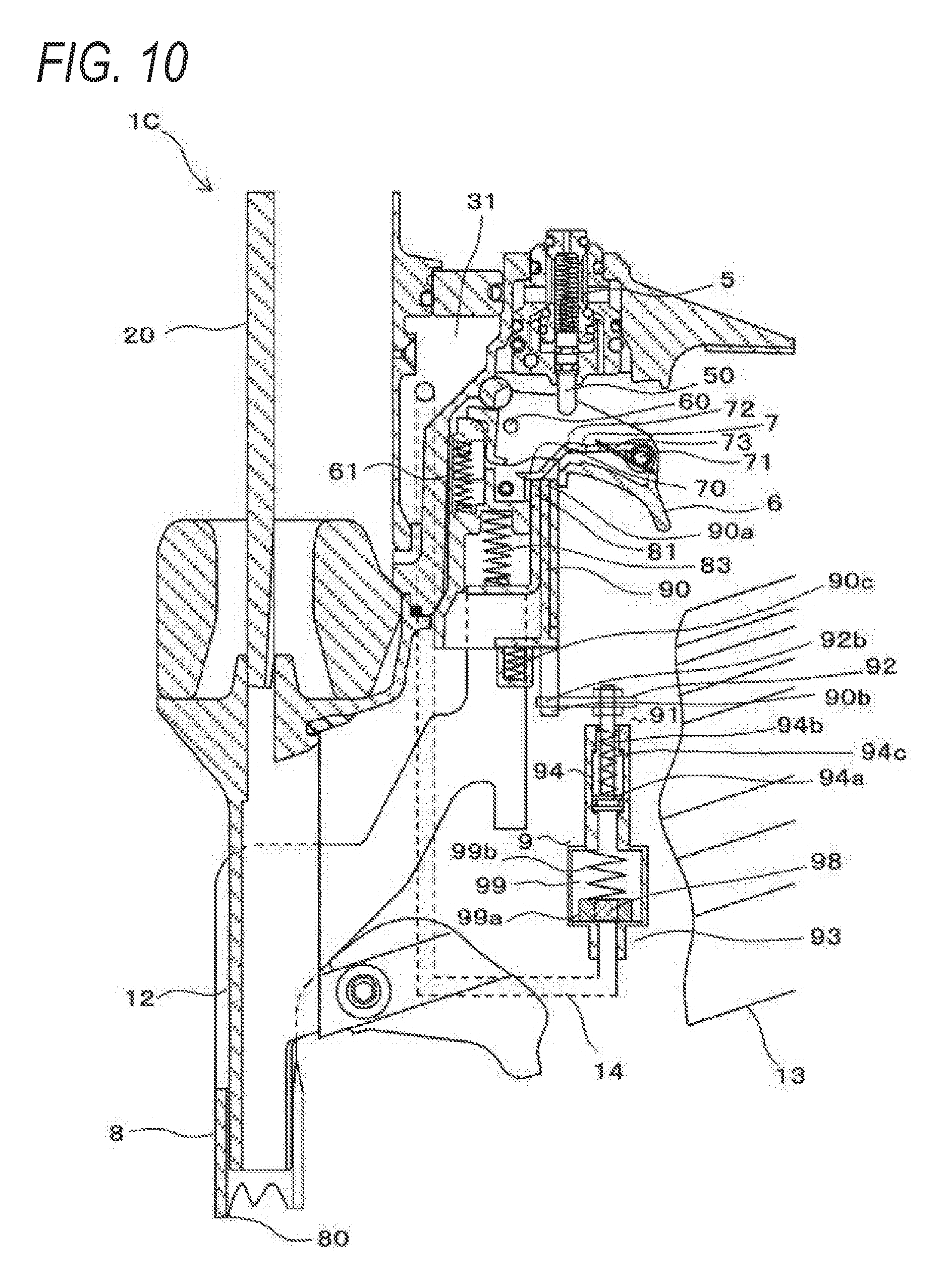
| United States Patent Application | 20190099871 |
| Kind Code | A1 |
| FUKUSHIMA; Naoyuki ; et al. | April 4, 2019 |
DRIVING TOOL
Abstract
A driving tool drives a fastener by a striking mechanism. The driving tool includes a trigger, a contact arm, a contact lever and a regulator. The trigger and the contact arm receive manipulations which operate the striking mechanism. The contact lever is movable according to operations of the trigger and the contact arm and switches operating states of the striking mechanism. The regulator regulates a movement of the contact lever according to a movement of the contact arm in which another manipulation is released. The regulator operates with a fluid for operating the striking mechanism, and keeps the contact lever at an operation standby position where the contact lever is operated by manipulation of the contact arm for a predetermined time period by controlling a flow rate of the fluid.
| Inventors: | FUKUSHIMA; Naoyuki; (Tokyo, JP) ; TANAKA; Hiroshi; (Tokyo, JP) ; SEKIGUCHI; Norimitsu; (Tokyo, JP) ; HOSHINO; Takamichi; (Tokyo, JP) | ||||||||||
| Applicant: |
|
||||||||||
|---|---|---|---|---|---|---|---|---|---|---|---|
| Assignee: | MAX CO., LTD. Tokyo JP |
||||||||||
| Family ID: | 63683044 | ||||||||||
| Appl. No.: | 16/138607 | ||||||||||
| Filed: | September 21, 2018 |
| Current U.S. Class: | 1/1 |
| Current CPC Class: | B25C 1/047 20130101; B25C 1/008 20130101; B25C 1/043 20130101; B25C 1/046 20130101; B25C 1/06 20130101 |
| International Class: | B25C 1/04 20060101 B25C001/04; B25C 1/00 20060101 B25C001/00 |
Foreign Application Data
| Date | Code | Application Number |
|---|---|---|
| Sep 29, 2017 | JP | 2017-191698 |
Claims
1. A driving tool which is configured to drive a fastener supplied to a nose by using a striking mechanism, the driving tool comprising: a trigger that is configured to receive a manipulation which operates the striking mechanism; a contact arm that is configured to receive another manipulation which operates the striking mechanism; a contact lever that is configured to be movable according to operations of the trigger and the contact arm and that is configured to switch operating states of the striking mechanism; and a regulator that is configured to regulate a movement of the contact lever according to a movement of the contact arm in which another manipulation is released, wherein the regulator is configured to operate with a fluid for operating the striking mechanism, and to keep a position of the contact lever at an operation standby position where the contact lever is operated by a manipulation of the contact arm for a predetermined time period by controlling a flow rate of the fluid.
2. The driving tool according to claim 1, wherein the regulator includes: a cylinder that is configured to be operated with the fluid for operating the striking mechanism; and a flow rate controller that is configured to interfer with a flow of the fluid discharged from the cylinder, and that is configured to control a velocity of a piston of the cylinder, and the flow rate controller controls an operating speed of the cylinder to regulate the movement of the contact lever.
3. The driving tool according to claim 2, wherein the flow rate controller includes a porous material through which the fluid passes to regulate the flow rate of the fluid.
4. The driving tool according to claim 2, further comprising: a check valve that is configured to open a flow path when the fluid is supplied to the cylinder, and that is configured to prevent backflow of the fluid in the cylinder.
5. The driving tool according to claim 4, wherein the check valve includes a sealing material to open and close the flow path and the flow rate controller is provided in the sealing material.
6. The driving tool according to claim 4, wherein The flow rate controller is provided in parallel with the check valve.
7. The driving tool according to claim 2, wherein the flow rate controller includes a load passage that is configured to regulate the flow rate of the fluid by passing the fluid with a predetermined load.
8. The driving tool according to claim 7, wherein the load passage includes at least one opening, the flow rate controller is configured to regulate the flow rate of the fluid by an area or the number of the opening included in the load passage.
Description
CROSS-REFERENCE TO RELATED APPLICATION
[0001] This application is based on and claims priority under 35 USC 119 from Japanese Patent Application No. P2017-191698 filed on Sep. 29, 2017.
TECHNICAL FIELD
[0002] The present invention relates to a driving tool driven by a fluid such as compressed air.
BACKGROUND
[0003] A driving tool called as a nailing machine is known, in which the driving tool operates a piston with a striking mechanism using a fluid such as compressed air as a driving power source and drives a driver coupled to the piston, in order to strike a fastener such as a nail coupled to a nose. In such a nailing machine, the striking mechanism is operated by manipulating two members, that is, one manipulation of pulling a trigger provided on a handle and another manipulation of pressing a contact arm that protrudes from a proximal end of the nose so as to reciprocate against a driven member, in order to drive a nail.
[0004] In following description, a state in which the trigger is pulled according to one manipulation will be referred to as ON state of the trigger, and a state in which one manipulation is canceled and the trigger is not pulled will be referred to as OFF state of the trigger. In another manipulation, a state in which the contact arm is pressed will be referred to as ON state of the contact arm, and a state in which another manipulation is canceled and the contact arm is not pressed will be referred to as OFF state of the contact arm.
[0005] In the nailing machine, for example, after the contact arm is ON, the trigger is ON in a state where the contact arm is ON, and whereby the striking mechanism is operated and a nail driving is performed.
[0006] After driving the nail, the trigger and the contact arm are OFF, and then, the trigger and the contact arm are ON again as described above, so that the striking mechanism is operated and a next nail driving is performed. As described above, for every nail driving operation, when the trigger and the contact arm are ON after the trigger and the contact arm are OFF, a next nail driving is performed, and this operation is referred to as a single shot mode.
[0007] On the other hand, a technique in which the trigger is maintained to be ON and the contact arm is OFF after driving the nail and then the contact arm is ON again to operate the striking mechanism and perform a next nail driving operation has been suggested. As described above, an operation of continuously performing nail driving operations by repeatedly turning ON/OFF of the contact arm in a state where the ON state of the trigger is maintained is referred to as a continuous strike mode.
[0008] In the continuous strike mode, the nail driving may be performed continuously whenever the contact arm is pressed against the driven member in a state where the trigger is pulled after each nail driving operation, and thus, the continuous strike mode is suitable for a fast work. On the other hand, in the single shot mode, since a next nail driving is performed by cancelling manipulations of the trigger and the contact arm after the nail is driven and by pulling the trigger after pressing the contact arm against the driven member, a careless operation may be restricted, but the single shot mode is not suitable for the fast work. Thus, there has been suggested a technique allowing continuous nail driving operations to be performed only with an operation of pressing the contact arm against the driven member without releasing the manipulation of the trigger for a predetermined time period after a first nail driving operation performed by pulling the trigger after pressing the contact arm against the driven member (for example, see JP-A-2016-179526).
SUMMARY
[0009] In the configuration in which the continuous strike operation of the nail, etc. may be performed only by pressing the contact arm against the driven member without releasing the manipulation of the trigger, a control allowing the continuous strike operation to be performed for a predetermined time period is made by using an electrical timer, and thus, a time measurement may be stabilized. However, the nailing machine driven by the compressed air does not use a source of electricity. Therefore, in order to use the electrical timer, a power source and a circuit are necessary.
[0010] The present invention has been made in view of these circumstances, and an object thereof is to provide a driving tool capable of measuring a time during which continuous strike operations may be performed by using a fluid that is a driving power of a device.
[0011] According to one aspect of the disclosure, a driving tool is configured to drive a fastener supplied to a nose by using a striking mechanism. The driving tool includes a trigger, a contact arm, a contact lever and a regulator. The trigger is configured to receive a manipulation which operates the striking mechanism. The contact arm is configured to receive another manipulation which operates the striking mechanism. The contact lever is configured to be movable according to operations of the trigger and the contact arm and is configured to switch operating states of the striking mechanism. The regulator is configured to regulate a movement of the contact lever according to a movement of the contact arm in which another manipulation is released. The regulator is configured to operate with a fluid for operating the striking mechanism, and to keep a position of the contact lever at an operation standby position where the contact lever is operated by a manipulation of the contact arm for a predetermined time period by controlling a flow rate of the fluid.
BRIEF DESCRIPTION OF THE DRAWINGS
[0012] FIG. 1 is a diagram showing a main configuration of a nailing machine according to a first embodiment;
[0013] FIG. 2 is a diagram showing whole configuration of a nailing machine according to the first embodiment;
[0014] FIG. 3 is a diagram for illustrating an example of a nail driving operation according to the first embodiment:
[0015] FIG. 4 is a diagram for illustrating an example of a nail driving operation according to the first embodiment:
[0016] FIG. 5 is a diagram for illustrating an example of a nail driving operation according to the first embodiment;
[0017] FIG. 6 is a diagram for illustrating an example of a nail driving operation according to the first embodiment;
[0018] FIG. 7 is a diagram for illustrating an example of a nail driving operation according to the first embodiment:
[0019] FIG. 8 is a diagram for illustrating an example of a nail driving operation according to the first embodiment:
[0020] FIG. 9 is a diagram showing a main configuration of a nailing machine according to a second embodiment; and
[0021] FIG. 10 is a diagram showing a main part of a nailing machine according to a third embodiment.
DETAILED DESCRIPTION
[0022] Hereinafter, a nailing machine as an example of a driving tool according to an embodiment of the present invention will be described with reference to accompanying drawings.
[0023] An example of a nailing machine according to a first embodiment
[0024] FIG. 1 is a diagram showing a main configuration of a nailing machine according to a first embodiment, and FIG. 2 is a diagram showing whole configuration of the nailing machine according to the first embodiment.
[0025] A nailing machine 1A according to the first embodiment includes a striking mechanism 2 including an air cylinder, etc. that operates by using a fluid such as compressed air as a driving source to perform a striking operation, and an air chamber 3 in which the compressed air supplied from an external air compressor (not shown) is stored. In the nailing machine 1A, the striking mechanism 2 is provided in a housing 10 extending in one direction, and the air chamber 3 is provided in a handle 11 extending from the housing 10 in another direction. In the nailing machine 1A, a blowback chamber 31 is provided around a lower portion of the striking mechanism 2 in the housing 10.
[0026] The striking mechanism 2 includes a driver 20 that strikes a nail, etc. (not shown), and a piston 21 in which the driver 20 is provided, wherein the piston 21 is provided to slide. In the striking mechanism 2, when the piston 21 is pressed by the compressed air, the piston 21 moves to drive the driver 20.
[0027] The compressed air is supplied to the air chamber 3 from a compressed air source, such as an air compressor, via an air plug 30 provided at an end portion of the handle 11. The compressed air for returning the piston 21 after the striking operation to an initial position is supplied to the blowback chamber 31.
[0028] The nailing machine 1A includes a nose 12 for accommodating the driver 20 at an end portion of the housing 10, and a magazine 13 for supplying a nail (not shown) to the nose 12. The nose 12 extends along a movement direction of the driver 20. In consideration of an aspect of using the nailing machine 1A, a side including the nose 12 is defined as a downward direction.
[0029] The nailing machine 1A includes a main valve 4 that controls inflow/outflow of the compressed air in the air chamber 3 and makes the piston 21 reciprocate, and a starting valve 5 that operates the main valve 4. The main valve 4 reciprocates the piston 21 by switching between inflow of the compressed air into the striking mechanism 2 from the air chamber 3 and discharge of the compressed air from the striking mechanism 2 to the outside. The starting valve 5 includes a valve stem 50 that is provided so as to reciprocate, and the valve stem 50 moves a predetermined distance and opens/closes a flow passage 40 to operate the main valve 4 and reciprocate the piston 21 once.
[0030] The nailing machine 1A includes a trigger 6 for receiving a manipulation of operating the starting valve 5, a contact arm 8 that moves by receiving a manipulation of pressing the contact arm 8 against a driven member, in which a nail is driven, and a contact lever 7 that is provided so as to operate according to an operation of the trigger receiving the manipulation and an operation of the contact arm 8 receiving another manipulation and is configured to switch an operating state of the striking mechanism 2 by switching an operating state of the starting valve 5. The nailing machine 1A includes a regulator 9 that regulates a movement, a velocity, or a moving amount of the contact lever 7 according to the reciprocating movement of the contact arm 8 for a predetermined time period, and switches the operating states of the contact arm 8 and the contact lever 7 according to whether the contact lever 7 and the contact arm 8 are locked by each other in the present example.
[0031] The trigger 6 is provided on a side of the handle 11, that is, on a side where the nose 12 is provided. An end portion of the trigger 6, that is, a side close to the housing 10, is rotatably supported by an axis 60. A side of the trigger 6, which is opposite to the side supported by the axis 60, that is, another end portion away from the housing 10, is biased by a spring 61 in a direction of moving towards the side on which the nose 12 is provided, by a rotating operation about the axis 60.
[0032] A movement range of the trigger 6 according to the rotation about the axis 60 is regulated by a collision of the trigger 6 with an abutting portion provided on the housing 10 and the handle 11. In a state where the manipulation of the trigger 6 is released, the trigger 6 is biased by the spring 61 to move to an initial position by rotating about the axis 60. The trigger 6 is moved from the initial position in the rotation operation about the shaft 60 to an operating position where the contact lever 7 may operate the starting valve 5, according to a pulling manipulation.
[0033] The contact lever 7 includes a lock portion 70, by which the contact arm 8 may be locked, at an end portion thereof, and the other end portion of the contact lever 7 is rotatably supported by the trigger 6 due to an axis 71. A pressing portion 72 that is capable of pressing the valve stem 50 of the starting valve 5 is provided between the lock portion 70 and the axis 71. In the contact lever 7, a side opposite to the side supported by the axis 71, that is, an end portion where the lock portion 70 is provided, is biased by a spring 73 such as a twisted coil spring in a direction of moving towards the nose 12 through a rotation about the axis 71.
[0034] The contact lever 7 is pressed by the contact arm 8, and is moved through the rotation about the axis 71 from an initial position to a location of operating the striking mechanism 2, that is, a preparation position where the valve stem 50 is pressed to operate the starting valve 5 in the present example, depending on the location of the trigger 6. When the trigger 6 is operated, the contact lever 7 is moved with the trigger 6 when the trigger 6 rotates about the axis 60.
[0035] As a result, the initial position and the operable position of the contact lever 7 are relative positions varying depending on a location of the trigger 6, and positions of the lock portion 70 and the pressing portion 72 of the contact lever 7 vary depending on whether the trigger 6 is at the initial position or a manipulation position and whether the contact lever 7 is at the initial position or the operable position.
[0036] The contact lever 7 is moved from the initial position to the operable position according to the operation of the contact arm 8, and is moved from the operable position to the initial position according to operations of the contact arm 8 and the regulator 9. The movement of the contact lever 7 between the initial position and the operable position will be described in detail later.
[0037] In a state where the trigger 6 and the contact lever 7 are moved to the initial position, the pressing portion 72 of the contact lever 7 is not in contact with the valve stem 50 of the starting valve 5. In a state where the contact lever 7 is moved to the initial position, the pressing portion 72 of the contact lever 7 is not in contact with the valve stem 50 of the starting valve 5 even when the trigger 6 is moved to the operable position. On the other hand, in a state where the contact lever 7 is moved to the operating position, when the trigger 6 is moved to the manipulation position, the pressing portion 72 of the contact lever 7 presses the valve stem 50 of the starting valve 5, and thus, the contact lever 7 may operate the starting valve 5.
[0038] The contact arm 8 is provided to be movable along an extending direction of the nose 12, and includes an abutting portion 80 that is brought into contact with a driven member at a proximal end side of the nose 12. The contact arm 8 includes a pressing portion 81 operating the contact lever 7 and a second pressing portion 82 operating the regulator 9. The contact arm 8 is pressed by a spring 83 in a direction of protruding from the proximal end side of the nose 12.
[0039] When the abutting portion 80 is pressed in contact with the driven member, the contact arm 8 is moved from the initial position to the operating position where the pressing portion 81 operates the contact lever 7 and the second pressing portion 82 operates the regulator 9.
[0040] When the pressing portion 81 is locked by the lock portion 70 of the contact lever 7 by the operation of the contact arm 8 moving from the initial position to the operating position, the contact lever 7 is operated by the operation of the contact arm 8 and the contact lever 7 is moved from the initial position to the operable position. Whether the lock portion 70 of the contact lever 7 and the pressing portion 81 of the contact arm 8 are locked or unlocked depends upon the position of the contact lever 7.
[0041] That is, in a state where the trigger 6 is moved to the initial position, when the contact arm 8 is moved to the operating position, the pressing portion 81 of the contact arm 8 is locked by the lock portion 70 of the contact lever 7 and the contact lever 7 is moved to the operating position. As such, when the trigger 6 is moved to the operating position, the pressing portion 72 of the contact lever 7 presses the valve stem 50 of the starting valve 5 and the contact lever 7 may operate the starting valve 5.
[0042] On the contrary, when the trigger 6 is moved to the operating position while the contact arm 8 is moving to the initial position, the pressing portion 81 is not locked by the lock portion 70 of the contact lever 7 even when the contact arm 8 is moved, and the pressing portion 72 of the contact lever 7 may not press the valve stem 50 of the starting valve 5 even when the trigger 6 is moved to the operating position.
[0043] As such, even when the trigger 6 is manipulated first and the contact arm 8 is manipulated, the starting valve 5 may not be operated, and when the contact arm 8 is pressed against the driven member, the continuous strike operation may not be performed. In the present embodiment, by providing the regulator 9, when the contact arm 8 is manipulated first and the trigger 6 is manipulated, the continuous strike operation may be enabled according to whether the contact arm 8 is manipulated or not for a predetermined time period.
[0044] The regulator 9 includes a regulation member 90 that regulates the movement, the velocity, or the moving amount of the contact lever 7 and regulates the position of the contact lever 7 to an operation standby position where the contact arm 8 may be operated. The operation standby position is a lockable position where the contact lever 7 may be locked by the contact arm 8. Also, the regulator 9 includes a damper 91 that maintains a state in which the contact lever 7 is located at the lockable position for a predetermined time period by controlling movement of the regulation member 90 that regulates the contact lever 7 at the lockable position. The regulator 9 is partially or entirely provided on an outer portion of the housing 10.
[0045] The lockable position of the contact lever 7 is a location or a range in which the contact lever 7 and the contact arm 8 may be locked by each other, and while the contact lever 7 stays at the location or the range, the contact arm 8 may operate the contact lever 7.
[0046] Therefore, the regulator 9 regulates the movement, the velocity, or the moving amount of the contact lever 7, the moving amount of the contact lever 7 in the present example, so that the contact lever 7 that has started to move from a preparation position may not pass over the lockable position for a predetermined time period.
[0047] The regulation member 90 is provided to be movable along a movement direction of the contact arm 8, and includes a pressing portion 90a that presses the contact lever 7 at an end portion thereof along the movement direction. Also, the regulation member 90 includes a locked portion 90b that may be locked by the damper 91.
[0048] The pressing portion 90a of the regulation member 90 is pressed by a spring 90c in a direction approaching the contact lever 7. The pressing portion 90a of the regulation member 90 presses the lock portion 70 of the contact lever 7, when the pressing portion 90a is adjacent to the pressing portion 81 of the contact arm 8 and the regulation member 90 is pressed to move by the spring 90c.
[0049] In addition, the regulation member 90 moves from the initial position, at which the pressing portion 90a is not in contact with the contact lever 7, to a return regulated position where the pressing portion 90a presses the contact lever 7 that is pressed by the contact arm 8 to move to the operable position to regulate the position of the contact lever 7 at the lockable position where the contact lever 7 and the contact arm 8 may be locked by each other.
[0050] The damper 91 includes a moving member 92 for moving the regulation member 90, and a controller 93 for controlling a velocity of the moving member 92. The regulator 9 is operated by the compressed air supplied from a working fluid passage 14. In the present example, the compressed air is supplied to the regulator 9 from the blowback chamber 32 filled with the air for returning the driver 20 after driving a nail (fastener). Since the compressed air is supplied to the blowback chamber 31 at a timing of returning the driver 20, the regulator 9 is operated by the compressed air only immediately after the nailing operation. The moving member 92 moves from an initial position where the regulation member 90 is moved to an initial position to a time measurement starting position where a measurement of time for regulating a movement, a velocity, or a moving amount, the moving amount in the present example, of the contact lever 7 that has moved to the lockable position is started. The moving member 92 is provided to be movable along a movement direction of the regulation member 90, and includes a lock portion 92b locked by the locked portion 90b of the regulation member 90.
[0051] The regulator 9 is provided with the locked portion 90b of the regulation member 90 on a movement path of the locked portion 90b according to the movement of the moving member 92. The damper 91 may release the locked state between the lock portion 92b of the moving member 92 and the locked portion 90b of the regulation member 90 by the operation of the moving member 92 moving from the initial position to the time measurement starting position. Therefore, the regulation member 90 is pressed by the spring 90c to be moved from the initial position to the return regulated position.
[0052] When the moving member 92 moves from the time measurement starting position to the initial position, the lock portion 92b of the moving member 92 and the locked portion 90b of the regulation member 90 are locked by each other. Therefore, the regulation member 90 is moved from the return regulated position to the initial position.
[0053] The controller 93 includes an air cylinder 94 operated when the compressed air is supplied thereto for moving the moving member 92, a check valve 96 for suppressing backflow of the air from the air cylinder 94 to the working fluid passage 14, and a flow rate controller 97 for controlling a flow rate of the air discharged from the air cylinder 94.
[0054] The air cylinder 94 is an example of a cylinder, and includes a piston 94a, a cylinder shaft 94b on which the piston 94a is provided, and a spring 94c pressing the piston 94a. In addition, the moving member 92 is coupled to the cylinder shaft 94b.
[0055] The check valve 96 includes a ball 96b opening/closing a flow path 96a, and a spring 96c pressing the ball 96b to the flow path 96a. The flow rate controller 97 is provided in parallel with the check valve 96, and includes a load passage 97a (aperture stop) that regulates a flow rate of the air per unit time by passing the air with a predetermined load. The load passage 97a includes one opening of a predetermined size.
[0056] The controller 93 moves the moving member 92 by using the spring 94c of the air cylinder 94 from the time measurement starting position to the initial position, and at the same time, controls a velocity of the moving member 92 by using a load (flow rate resistance) that is generated when the air pushed by the piston 94a of the air cylinder 94 passes through the load passage 97a of the flow rate controller 97.
[0057] Thus, a time taken for the moving member 92 to move from the time measurement starting position to the initial position may be controlled, and a time taken for the regulation member 90 to move from the return regulated position to the initial position may be controlled. Therefore, a time taken for the contact lever 7 that has moved to the lockable position to return to the initial position may be controlled.
[0058] An example of a nailing operation according to the first embodiment
[0059] FIGS. 3 to 8 are diagrams for describing an example of driving a nail according to the first embodiment, and operations of the nailing machine 1A according to the first embodiment will be described below with reference to accompanying drawings.
[0060] In an initial state, as shown in FIG. 1, the trigger 6 is at the initial position without being pulled, and the contact arm 8 is also at the initial position without being pushed by the driven member. Therefore, the contact lever 7, the regulation member 90, and the moving member 92 are respectively at the initial positions thereof.
[0061] In the initial state in which the trigger 6 is at the initial position and the contact lever 7 is at the initial position, the lock portion 70 of the contact lever 7 is located on the movement path of the pressing portion 81 of the contact arm 8.
[0062] In the initial state of FIG. 1, when the contact arm 8 is forcedly moved by the driven member from the initial position to the operating position, the pressing portion 81 of the contact arm 8 presses the lock portion 70 of the contact lever 7 as shown in FIG. 3. Then, the contact lever 7 is moved from the initial position to a preparation position where the valve stem 50 of the starting valve 5 may be pressed to operate the starting valve 5, by rotating about the axis 71. Even when the contact lever 7 moves to the operating position, the valve stem 50 is not pressed by the contact lever 7 unless the trigger 6 is moved to the operating position.
[0063] After the contact arm 8 is moved to the operating position by being forcedly pressed by the driven member in the initial state, when the trigger 6 is pulled to be moved from the initial position to the operating position, the pressing portion 72 of the contact lever 7, which is at the operable position, presses the valve stem 50 of the starting valve 5, as shown in FIG. 4. As a result, the main valve 4 is controlled, the striking mechanism 2 is driven by the compressed air, and the driver 20 is moved in a direction in which a fastener (not shown), that is, a nail in the present example, is driven. Thus, an operation of driving a nail (not shown) may be performed. After the driving operation, the compressed air is supplied from the blowback chamber 31 to the striking mechanism 2, and the driver 20 moves in a returning direction.
[0064] In addition, together with the driving operation of a nail, when some of the compressed air is supplied from the blowback chamber 31 to the controller 93 of the damper 91, the ball 96b of the check valve 96 is pressed.
[0065] As a result, the flow path 96a of the check valve 96 is open and the compressed air is supplied to the air cylinder 94. The piston 94a of the air cylinder 94 is pressed when the air is supplied. Therefore, the moving member 92 provided on the cylinder shaft 94b of the air cylinder 94 moves from the initial position to the time measurement starting position.
[0066] When the moving member 92 moves to the time measurement starting position, the locked state between the lock portion 92b of the moving member 92 and the locked portion 90b of the regulation member 90 is released, and the regulation member 90 is pressed by the spring 90c to move from the initial position to the return regulated position.
[0067] After the driving operation, while the trigger 6 is maintained at the operating position in a state of being pulled, when the force applied to the contact arm 8 is released, as shown in FIG. 5, the contact arm is moved from the operating position to the initial position by a force of the spring 83.
[0068] When the contact arm 8 is moved to the initial position, the pressed state of the contact lever 7 by the pressing portion 81 is released, and the contact lever 7 starts to move in a direction of returning to the initial position from the operable position by rotating about the axis 71 due to the spring 73.
[0069] The pressing portion 90a of the regulation member 90 moving to the return regulated position is located on the movement path of the contact lever 7, and regulates the moving amount of the contact lever 7 that moves in a direction of returning from the operable position to the initial position.
[0070] As a result, when the contact arm 8 moves to the initial position, the contact lever 7 moves until the contact lever 7 contacts the pressing portion 90a of the regulation member 90 and then stops at the lockable position. In addition, the lock portion 70 of the contact lever 7 that moved to the lockable position is located on a movement path of the pressing portion 81 of the contact arm 8.
[0071] In addition, when supply of the compressed air from the working fluid passage 14 is stopped, the ball 96b of the check valve 96 is pressed by the spring 96c to block the flow path 96a. Also, when the piston 94a of the air cylinder 94 is pressed by the spring 94c, the moving member 92 starts to move in a direction of returning to the initial position from the time measurement starting position.
[0072] A velocity of the moving member 92 is controlled, in the controller 93, when the piston 94a of the air cylinder 94 is moved and the flow rate of the air discharged from the air cylinder 94 is restricted by a load of the load passage 97a. As a result, as shown in FIG. 6, the lock portion 92b of the moving member 92 and the locked portion 90b of the regulation member 90 are not in locked state until the moving member 92 moves to the initial position, and the regulation member 90 stops at the return regulated position.
[0073] Therefore, while the moving member 92 moves from the time measurement starting position to the initial position, the contact lever 7 is stopped at the lockable position, and the lock portion 70 is located on the movement path of the pressing portion 81 of the contact arm 8.
[0074] As a result, while the trigger 6 is maintained at the operating position in a state of being pulled, before a predetermined time period passes after the contact arm 8 moves to the initial position and before the moving member 92 moves from the time measurement starting position to the initial position, when the contact arm 8 is moves from the initial position to the operating position by being pressed by the driven member again, the pressing portion 81 of the contact arm 8 may press the lock portion 70 of the contact lever 7.
[0075] Therefore, after the contact arm 8 is moved to the initial position while maintaining the trigger 6 at the operating position in a state of being pulled, when the contact arm 8 is moved again to the operating position, as shown in FIG. 4, the lock portion 70 of the contact lever 7 is pressed by the pressing portion 81 of the contact arm 8, the contact lever 7 is moved to the operating position, and then, the pressing portion 72 presses the valve stem 50 of the starting valve 5.
[0076] Therefore, while the trigger 6 is maintained at the operating position in a state of being pulled, continuous striking operations may be performed for a predetermined time period by pressing the contact arm 8 against the driven member.
[0077] On the other hand, while the trigger 6 is at the operating position in a state of being pulled, when a predetermined time passes after the contact arm 8 moves to the initial position, the moving member 92 is moved to the initial position by the air cylinder 94.
[0078] When the moving member 92 is moved to the initial position, as shown in FIG. 7, the lock portion 92b of the moving member 92 and the locked portion 90b of the regulation member 90 are locked by each other. Then, the regulation member 90 pressed by the moving member 92 that is moved by the air cylinder 94 is moved from the return regulated position to the initial position.
[0079] When the regulation member 90 is moved to the initial position, the contact lever 7 is moved from the lockable position to the initial location by rotating about the axis 71 due to the spring 73, in a case where the trigger 6 is at the operating position. When the contact lever 7 is moved to the initial position in a state where the trigger 6 is maintained at the operating position, the lock portion 70 of the contact lever 7 is evacuated from the movement path of the pressing portion 81 of the contact arm 8.
[0080] As a result, after the contact arm 8 is moved to the initial position, when a predetermined time passes while the trigger 6 is maintained at the operating position in a state of being pulled, as shown in FIG. 8, the pressing portion 81 of the contact arm 8 does not contact the lock portion 70 of the contact lever 7 and the contact lever 7 is not pressed even when the contact arm 8 is moved to the operating position by the operation of pressing the contact arm 8 against the driven member.
[0081] Therefore, the starting valve 5 is not pressed by the contact lever 7, and the striking operation is not performed. While the trigger 6 is at the operating position in a state of being pulled, a continuous strike operation performed by pressing the contact arm 8 against the driven member may be controlled according to lapse of time by using a mechanical configuration capable of adjusting a flow rate of the air. Further, the flow rate of the compressed air may be regulated by an area or the number of the opening included in the load passage 97a. As a result, measurement of a time during which the continuous strike operation may be performed by using the compressed air that is a driving source of the nailing machine 1A, and thus, a state in which a continuous driving operation of a nail may be performed and a state in which the continuous driving operation may not be performed may be switched with a predetermined timing. Further, the air cylinder 94 that generates a flow of the compressed air, the flow rate of which is regulated for the time measurement, may be operated by the compressed air in a state in which the time measurement is started, and there is no need to provide a power source of the air cylinder 94.
[0082] In addition, the regulator 9 operates the moving member 92 and the regulation member 90 with the compressed air supplied from the blowback chamber 31 to the air cylinder 94 to start the measurement of the time for maintaining the contact lever 7 at the lockable position (operation standby position) where the contact lever 7 may be operated by the contact arm 8, and thus, the time measurement may be definitely started after driving the nail (fastener) and inactivation of the contact lever 7 because the time measurement is finished before driving the nail may be prevented.
[0083] A configuration of maintaining the locked state between the contact lever and the contact arm for a predetermined time period by decreasing the velocity of the contact lever to increase a time taken for the contact lever to move to the initial position may be suggested.
[0084] However, it is difficult to stably decrease the velocity of the contact lever, and it is also difficult to stably switch the locked state between the contact lever and the contact arm at a predetermined timing. On the other hand, by providing the regulation member 90 for regulating the moving amount of the contact lever 7 and controlling the movement of the regulation member 90 by using the damper 91, the locked state between the contact lever 7 and the contact arm 8 may be stably switched at a predetermined timing by using a mechanical configuration.
[0085] Alternatively, a configuration of combining the damper with the trigger may be suggested in order to decrease the velocity of the contact lever. However, since there is a need to combine the mechanical time measurement mechanism in a restricted area, for example, it is difficult to stably decrease the velocity of the contact lever in order to measure the time. On the other hand, a configuration for stably performing a measurement operation, for example, increasing of a moving amount of the air cylinder 94 by providing the regulator 9 on an outer portion of the housing 10, may be easily implemented.
[0086] When a predetermined time passes after finishing the nailing operation as described above, the contact lever 7 is moved to the initial position. After the contact lever 7 is moved to the initial position, the contact arm 8 is moved to the initial position by releasing the force applied to the contact arm 8. Also, the trigger 6 is moved to the initial position when the force of pulling the trigger 6 is released. As a result, the initial state as shown in FIG. 1 may be obtained. In the initial state, the lock portion 70 of the contact lever 7 is moved to the movement path of the pressing portion 81 of the contact arm 8.
[0087] As shown in FIG. 3, after the contact arm 8 is moved to the operating position by pressing the contact arm 8 against the driven member, as shown in FIG. 4, when the trigger 6 is pulled to move to the manipulation position, the valve stem 50 of the starting valve 5 is pressed by the contact lever 7 moving to the operable position and the nailing operation may be performed.
[0088] In the initial state shown in FIG. 1, when the trigger 6 is pulled and moved to the operating position before pressing the contact arm 8 against the driven member, the lock portion 70 of the contact lever 7 is evacuated from the movement path of the pressing portion 81 of the contact arm 8.
[0089] As a result, after setting the trigger 6 at the operating position in a state of pulling the trigger 6, even when the contact arm 8 is moved to the operating position by pressing the contact arm 8 against the driven member, the pressing portion 81 of the contact arm 8 does not contact the lock portion 70 of the contact lever 7 and thus the contact lever 7 is not pressed.
[0090] Therefore, the valve stem 50 of the starting valve 5 is not pressed by the contact lever 7, and the striking operation is not performed. Therefore, before the trigger 6 is pulled, a nailing operation caused by other operations than a regular procedure of pressing the contact arm 8 against the driven member may be restricted.
[0091] An example of a nailing machine according to a second embodiment
[0092] FIG. 9 is a diagram showing a main configuration of a nailing machine according to a second embodiment. In the nailing machine 1B according to the second embodiment, like reference numerals denote the same elements as those of the nailing machine 1A according to the first embodiment, and descriptions about the same elements are omitted.
[0093] The nailing machine 1B according to the second embodiment includes a flow rate controller 97B that controls a flow rate of the air flowing from the air cylinder 94 in the regulator 9. The flow rate controller 97B is provided in parallel with the check valve 96, and includes a filter 98 for adjusting a flow rate of the air per unit time by passing the air with a predetermined load. The filter 98 includes a porous material.
[0094] The controller 93 moves the moving member 92 from the time measurement starting position to the initial position by using the spring 94c of the air cylinder 94, and at the same time, controls a velocity of the moving member 92 with a load that is generated when the air pressed by the piston 94a of the air cylinder 94 passes through the filter 98 of the flow rate controller 97B.
[0095] In order to regulate the flow rate of the air and stably perform the time measurement, it is important to generate a resistance by applying an appropriate load to the air flow. As illustrated in the first embodiment, in a configuration of regulating the flow rate of the air by providing an opening that serves as a load to the air flow in the flow path, management of the flow rate through the management of a size of the opening, for example, size management of a diameter of the opening provided that the opening has a circular cross-section, is an important factor for stably performing the time measurement.
[0096] It is necessary to miniaturize the opening in order to increase a time for the time measurement, but in processing an opening having a diameter of 1 mm or less, a variation in diameter for each product is likely to occur. In order not to generate a deviation among the products, it is necessary to improve a processing accuracy and quality management, and management costs increase. Thus, there is a limitation in managing the variation.
[0097] In addition, in a case where the flow rate is controlled by the opening having a small diameter, when a foreign substance such as dust or oil is attached to the opening, the flow rate largely fluctuates, and thus, it is necessary to remove the foreign substance. Therefore, according to the related art, an amount of the air accumulated in the cylinder may be increased without extremely reducing the diameter of the opening.
[0098] On the other hand, in a configuration of using the filter 98 including a porous material as in the second embodiment, the air passes through a plurality of pores, and thus, it is easy to manage the flow rate. Also, since the load may be determined according to selection of materials having pores of different sizes from one another and a variation in a thickness of the filter 98, it is easy to obtain a constant flow rate and to improve accuracy in the measurement.
[0099] Accordingly, when the flow rate controller 97B uses the filter 98 including the porous material, it is easy to control the load by changing a size and a thickness of the pore, the velocity of the moving member 92 may be controlled accurately, and a time setting may be easily performed when compared with the first embodiment, in which the load passage 97a including the opening is used. In addition, an adjustment according to a volume of the cylinder is not necessary, and thus, a main body of the machine may not increase in size.
[0100] An example of driving a nail according to a third embodiment
[0101] FIG. 10 is a diagram showing a main configuration of a nailing machine according to a third embodiment. Here, in a nailing machine 1C according to the third embodiment, like reference numerals denote the same elements as those of the nailing machine 1A according to the first embodiment, and descriptions about the same elements are omitted.
[0102] The nailing machine 1C according to the third embodiment includes a check valve 99 for presenting backflow of the air from the air cylinder 94 to the working fluid passage 14. The check valve 99 includes a sealing material 99a for opening/closing a flow path and a spring 99b pressing the sealing material 99a. In addition, the check valve 99 includes the filter 98 for passing the air with a predetermined load, and the check valve 99 constitutes a flow rate controller that controls the flow rate of the air flowing from the air cylinder 94. The filter 98 includes a porous material.
[0103] With the operation of driving a nail, the sealing material 99a of the check valve 99 is pressed when the compressed air is supplied to the controller 93 of the damper 91 via the working fluid passage 14. Since the filter 98 serves as a load to the flow of the air, the sealing material 99a is pressed and the flow path of the check valve 99 is open, and the air is transferred to the air cylinder 94.
[0104] The controller 93 moves the moving member 92 from the time measurement starting position to the initial position by using the spring 94c of the air cylinder 94, and at the same time, controls the velocity of the moving member 92 with the load generated when the air pressed by the piston 94a of the air cylinder 94 passes through the filter 98 of the check valve 99.
[0105] By providing the filter 98 in the sealing material 99a of the check valve 99, the check valve 99 may have a function of the flow rate controller, and a size may be miniaturized when compared with a configuration in which the check valve and the flow rate controller are separately provided. Also, since the filter 98 is used as the flow rate controller, it is easy to control the load and to control the velocity of the moving member 92. Alternatively, the sealing material 99a may entirely include the porous material.
[0106] In each of the above-described embodiments, the regulator 9 is configured to operate with the compressed air supplied from the blowback chamber 31 filled with the air for returning the driver 20 after driving a nail (fastener). On the other hand, the regulator may have a configuration in which the compressed air is supplied from the striking mechanism 2, or may be supplied from the starting valve 5. Alternatively, the compressed air operating a feed member of a nail (not shown) may be supplied.
* * * * *
D00000

D00001

D00002

D00003

D00004

D00005

D00006

D00007

D00008

D00009

D00010

XML
uspto.report is an independent third-party trademark research tool that is not affiliated, endorsed, or sponsored by the United States Patent and Trademark Office (USPTO) or any other governmental organization. The information provided by uspto.report is based on publicly available data at the time of writing and is intended for informational purposes only.
While we strive to provide accurate and up-to-date information, we do not guarantee the accuracy, completeness, reliability, or suitability of the information displayed on this site. The use of this site is at your own risk. Any reliance you place on such information is therefore strictly at your own risk.
All official trademark data, including owner information, should be verified by visiting the official USPTO website at www.uspto.gov. This site is not intended to replace professional legal advice and should not be used as a substitute for consulting with a legal professional who is knowledgeable about trademark law.